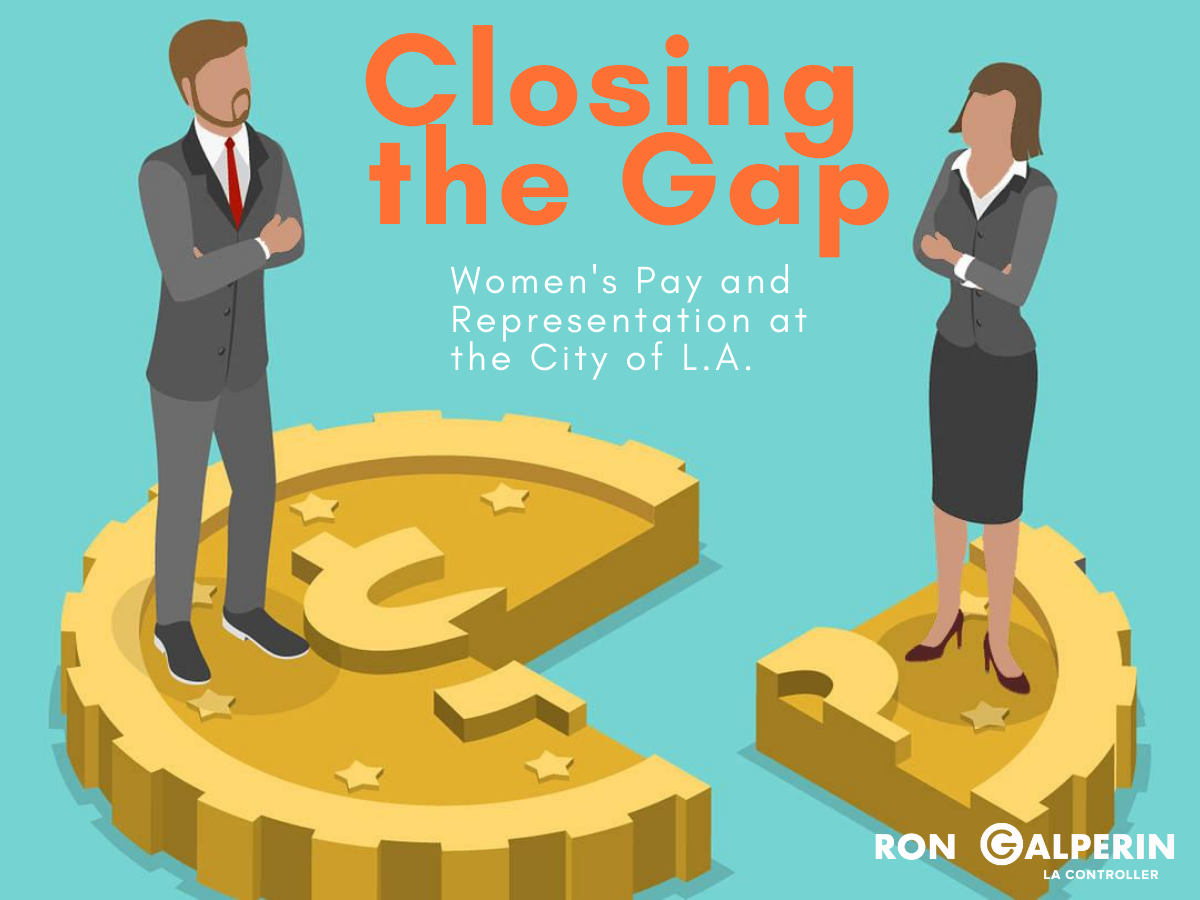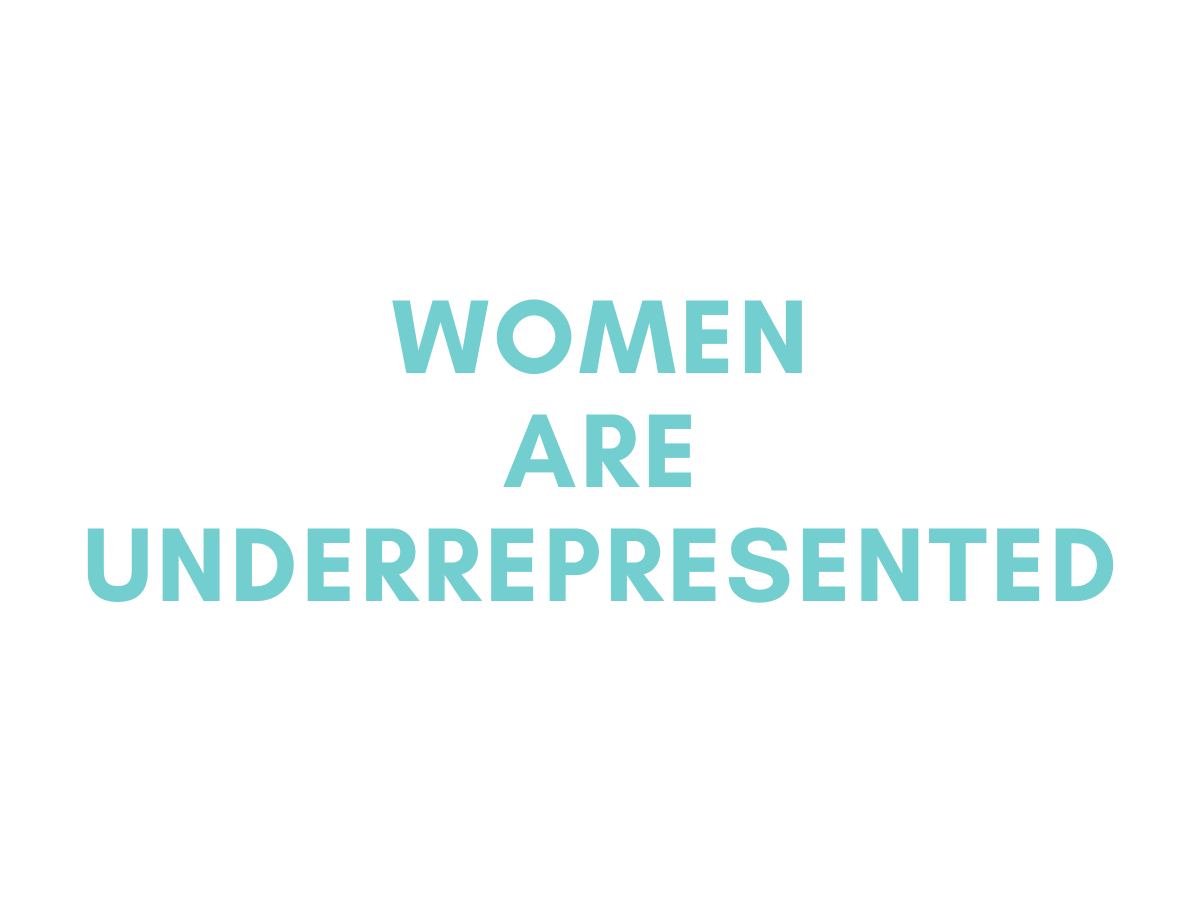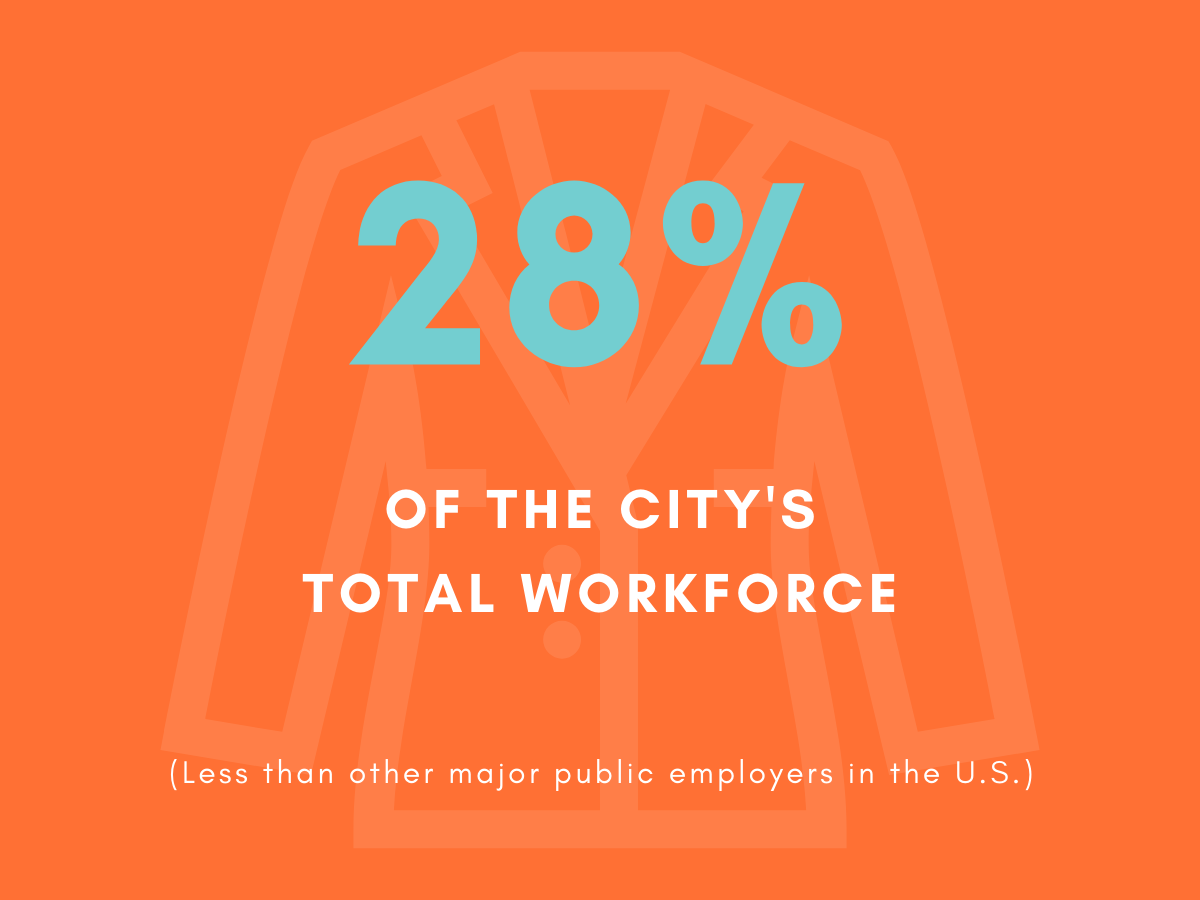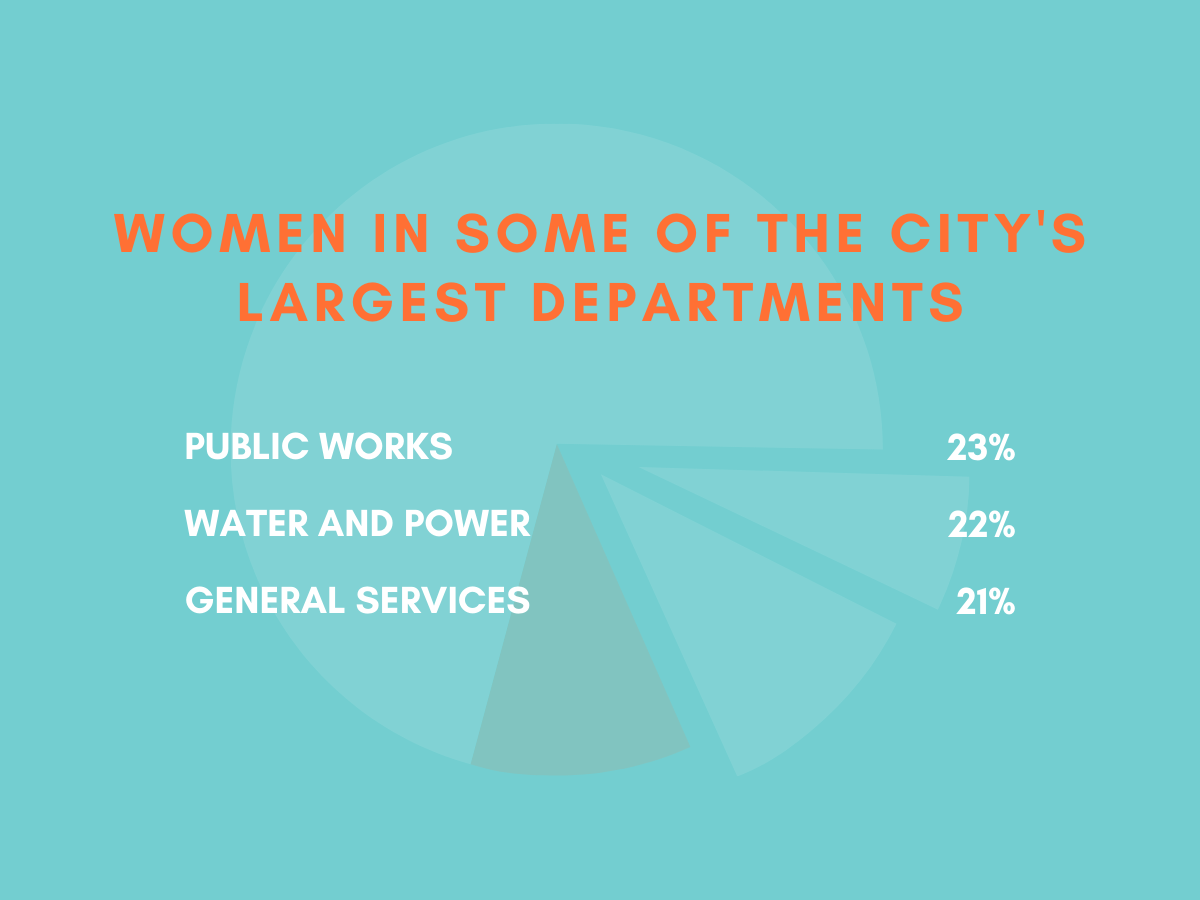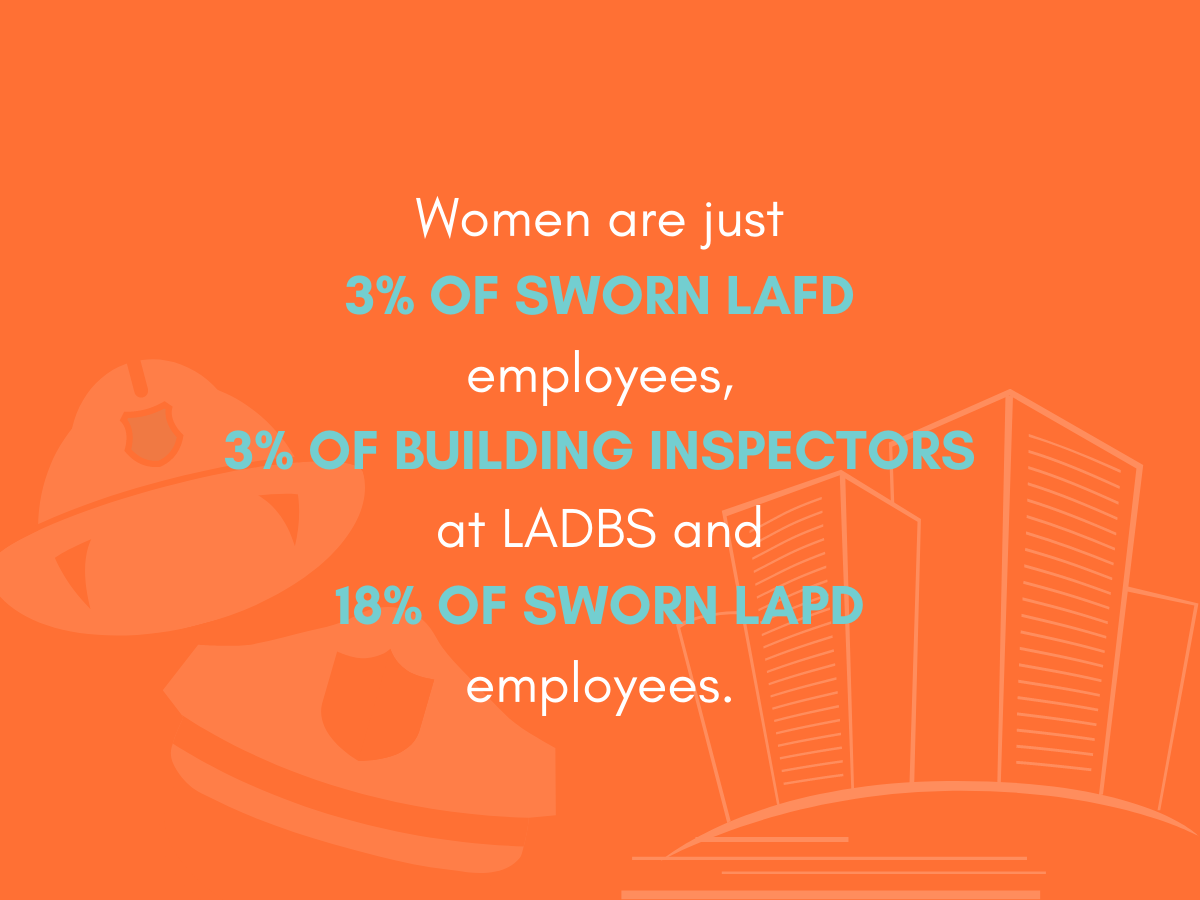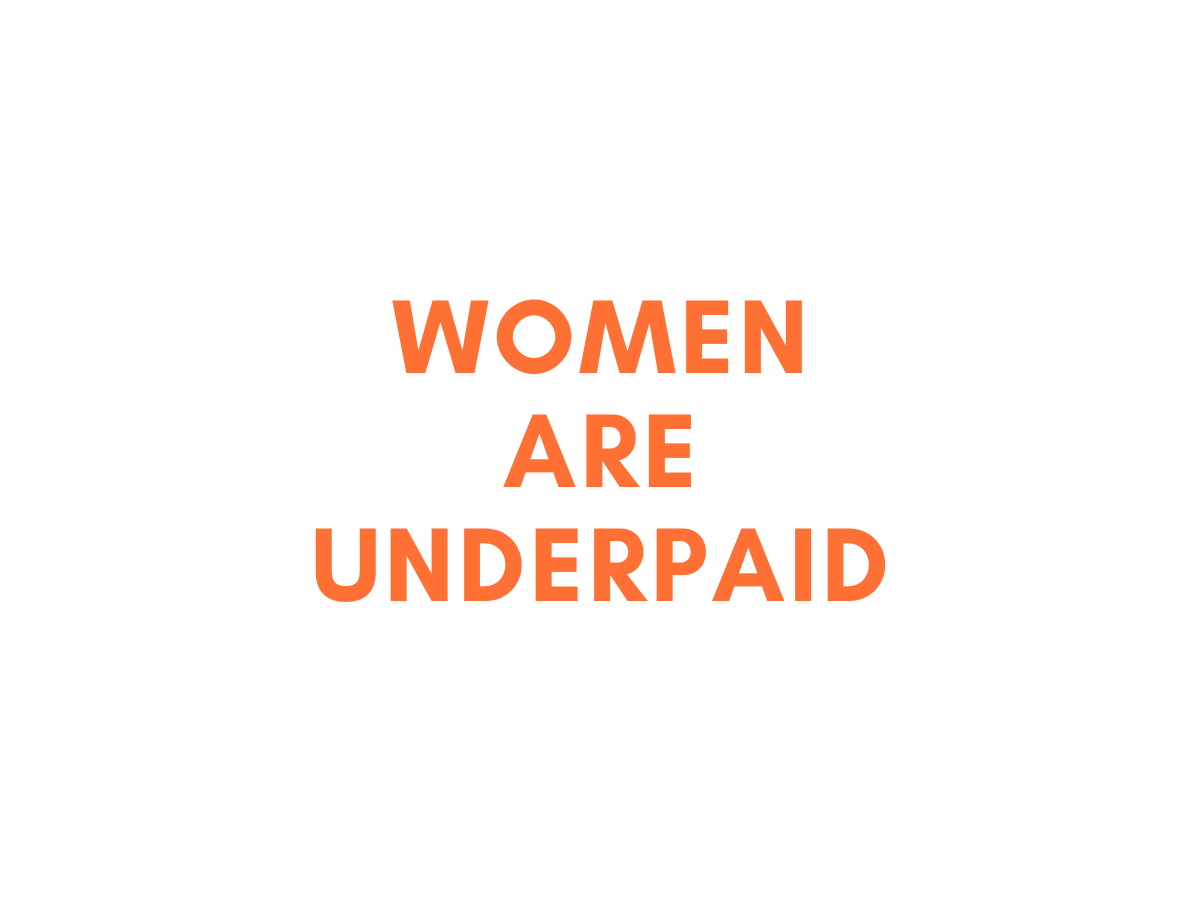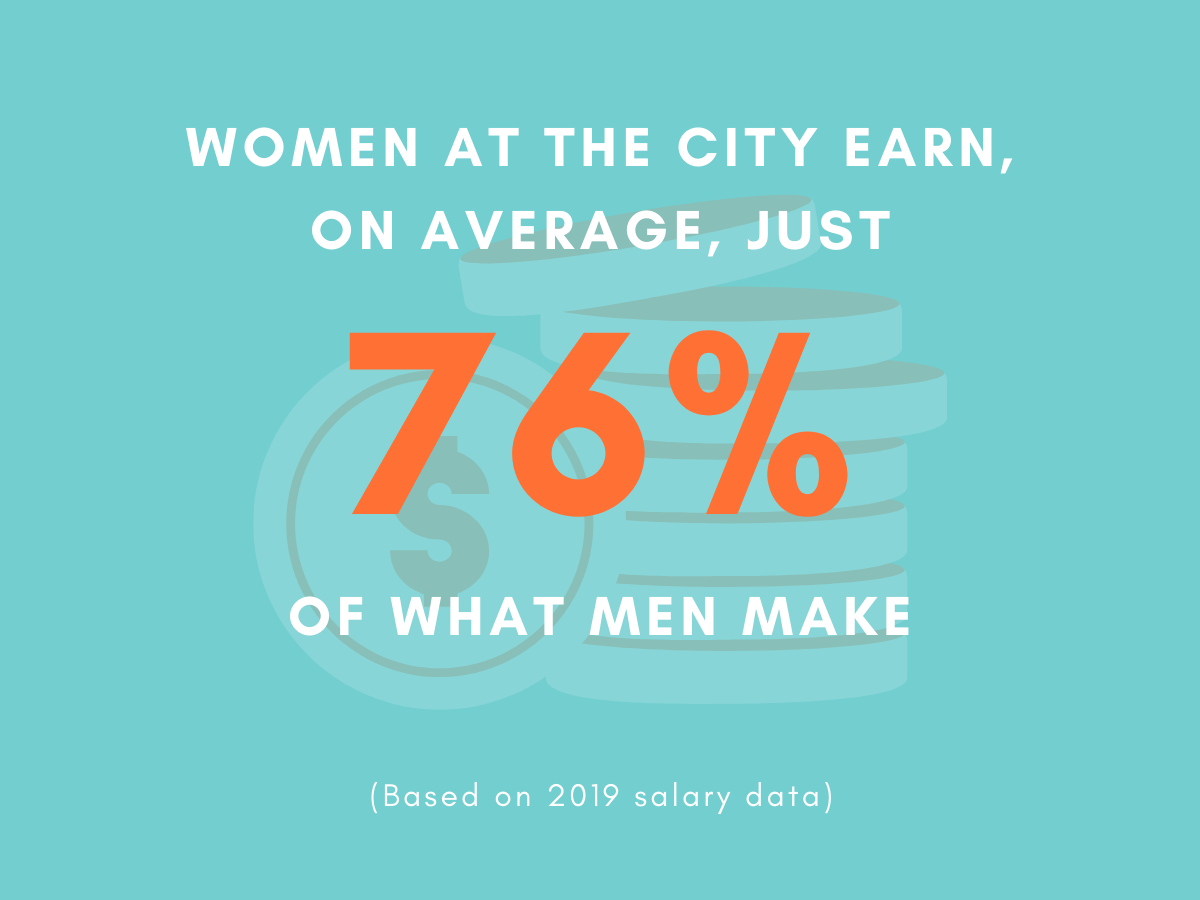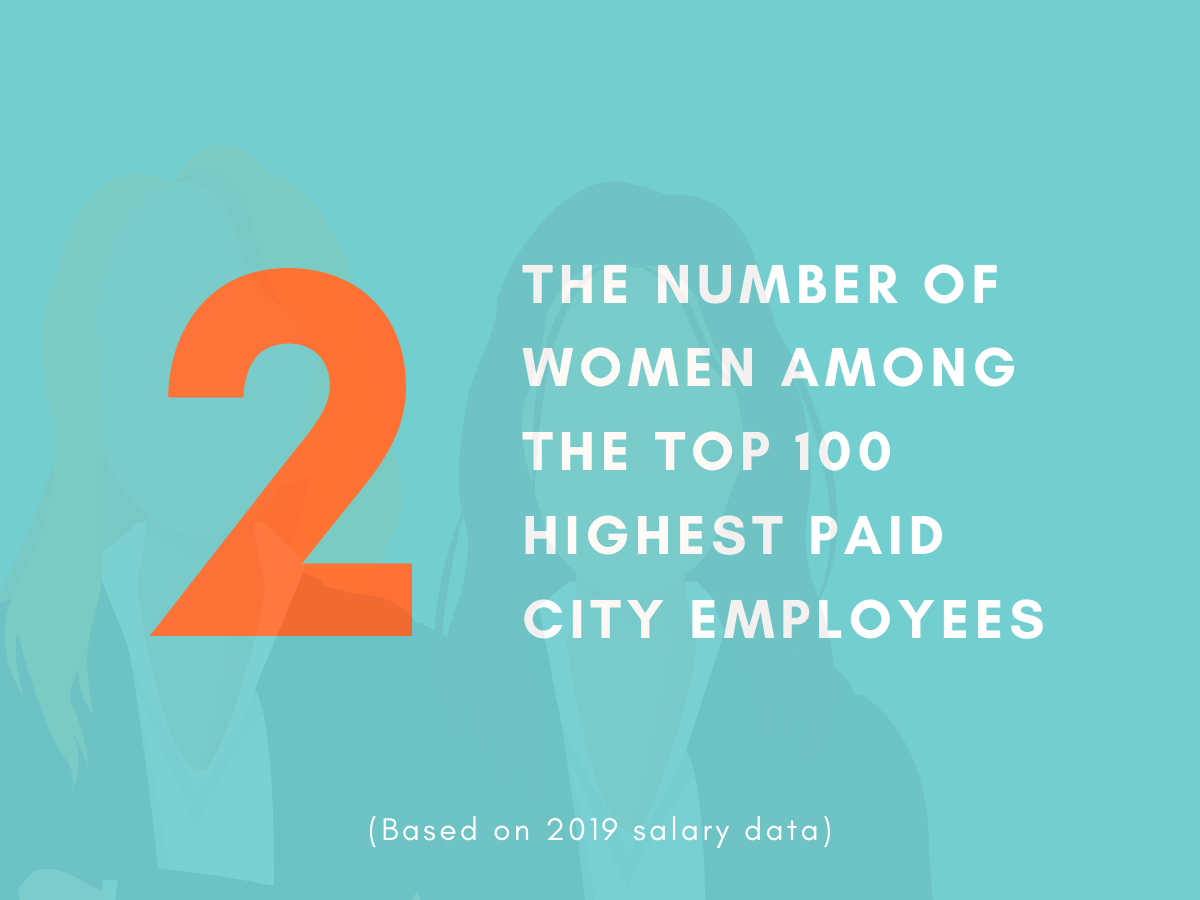Closing the Gap: Women’s Pay and Representation at the City of L.A.
2020 City of Los Angeles
Report
Gender equity is a goal both private and public sector employers strive to achieve, yet it remains frustratingly elusive to most. While women in California have achieved a slightly narrower pay gap than women in other states, and the City of Los Angeles has distinguished itself by taking affirmative steps to improve women’s access to better jobs and pay, there remains considerable room for improvement. This report addresses the issue of gender equity at the City by taking a closer look at the workforce, along with the corresponding pay of women and men overall and in each department.
Each bar below contains a section of the report. Click on any to expand and read the full text of the section. Click again to collapse.
August 5, 2020
Honorable Eric Garcetti, Mayor
Honorable Michael Feuer, City Attorney
Honorable Members of the Los Angeles City Council
Re: Closing the Gap: Women’s Pay and Representation at the City of L.A.
Gender equity is a goal both private and public sector employers strive to achieve, yet it remains frustratingly elusive to most. At its core, gender equity is about making sure women and men have equal access to the same resources and opportunities for success. But equity is both different from and requisite to equality — which only works if everyone starts from a comparable place. The concept of equity, as compared to equality, takes into consideration the unequal nature of our society and its institutions, including the workplace.
According to a 2018 Census Bureau study, women earn less than 82 cents for every dollar earned by men in the United States. This is an obvious matter of inequality, but to address and erase this gap will take more than dollars and cents — it will take rethinking and restructuring the way women are recruited, hired, promoted and paid, among other things. Only by paying attention to systemic inequities in all these areas will women eventually have a more leveled opportunity to become business leaders, tech CEOs and fire captains in cities across the country.
This is as true in the City of Los Angeles as anywhere in the nation. While women in California have achieved a slightly narrower pay gap than women in other states, and the City of Los Angeles has distinguished itself by taking affirmative steps to improve women’s access to better jobs and pay, there remains considerable room for improvement. My latest report addresses the issue of gender equity at the City by taking a closer look at the workforce, along with the corresponding pay of women overall and in each department.
Underrepresented and underpaid
A payroll analysis completed by my office found that, despite the Mayor’s 2015 Executive Directive on “Gender Equity in City Operations,” which tasked all City departments with developing action plans to close existing gender gaps, and the Personnel Department’s efforts to recruit and hire more women into civil service jobs, the City has fallen short of its worthy goals. Women remain both underrepresented and underpaid when compared to their male co-workers.
Women currently represent only 28 percent of the City’s workforce — the same percentage as in 2015 and far less than similar jurisdictions in California and across the country. In addition, women working at the City earn, on average, just 76 percent of what men make and took home just 24 percent of the gross amount the City paid its employees last year. Most alarmingly, my office found that women earned nine percent of the $884 million in overtime paid by the City in 2019, with men earning $801.5 million, or 91 percent of all overtime. And only two of the 100 highest paid City of Los Angeles employees were women, with the remaining 98 top earners men.
Gender inequity is particularly pronounced in the City’s largest departments: Police, Water and Power, Public Works, Fire, Airports, Transportation and General Services. Women represent between seven and 34 percent of the workforce in these departments. When it comes to sworn workers, the numbers dip even lower: women are just three percent of sworn Fire Department employees and 18 percent of sworn Police Department employees, limiting access to thousands of high paying City jobs that also accrue significant overtime hours.
Pathway to progress
While it is impossible to create gender equity overnight, the City must take additional steps to develop a more diverse and representative workforce, which will also help close the existing pay gap between women and men. My report makes the following recommendations:
- Develop a strategic plan with clear goals to better recruit, hire, develop and retain women in departments across the City.
- Create a working group of City officials and community and labor partners tasked with designing a clear pathway to help women participate in all job classifications and promotional opportunities, focused especially on higher paying jobs with access to overtime.
- Require the largest City departments to submit annual reports on their efforts to attract more women to entry level jobs that traditionally have been dominated by men.
I urge City leaders to adopt these recommendations to ensure that our City makes meaningful progress toward gender equity in the years ahead. By turning our intentions into action, the City can make a difference for our hardworking women employees and those we hope to recruit to the workforce in the future.
Respectfully submitted,

RON GALPERIN
L.A. Controller
Concerted efforts have been made to promote inclusion and remove institutional barriers; nonetheless, many employers across the country – including the City of Los Angeles – continue to fall short of achieving gender equity in the workplace. Closing the gender gap in government is especially important not only due to government’s unique role in shaping public policy, but because the City works for the people of Los Angeles, and its ranks should reflect the diversity of the community it serves.
The City has made improving gender equity a priority in recent years. The Mayor issued Executive Directive No. 11 (“Gender Equity in City Operations”) in August 2015 and tasked general managers with developing action plans to close existing gender gaps. The Personnel Department evaluates gender balance each time a civil service job application is offered. When women are underrepresented, a Targeted Recruitment Plan is developed; these plans may include targeted advertising and outreach, as well as testing and evaluation techniques aimed at achieving better representation.
Despite these efforts, the results have not come to fruition. The data shows that the City has significantly lower levels of women represented in the workforce as compared to other large jurisdictions. Women also lag behind men in hourly pay and gross amounts earned, which include bonuses and overtime.
- Women comprise only 28 percent of the City’s full-time workforce.
- When looking at gross annual pay, women averaged $90,058, compared to an average of $118,454 for men; in other words, the average woman’s paycheck is about 76% that of the average man’s paycheck.
- Of the top 100 highest paid employees, two were women. Those women were the Chief Legislative Analyst (23rd highest paid) and the General Manager of Los Angeles World Airports (28th highest paid). The highest paid City employee was a Chief Port Pilot.
- Overall, City employees received paid overtime totaling $884 million over an annual period. Men received 91% of that amount, or $801 million, while women earned a total of $82.7 million in overtime.
The magnitude of these disparities makes an overnight transformation impossible. This report, an analysis of payroll data is intended to provide a snapshot of the City’s workforce through the lens of gender equity and establish a baseline against which future programmatic efforts can be measured. We offer the following recommendations to City Leaders:
- Develop a strategic plan with goals and strategies to attract, develop, and retain diverse talent pools and heighten the cultural competencies of City leadership and its workforce.
- Require annual reports to be submitted by the Personnel Department, in conjunction with Police, Fire, Public Works, LADWP, Airports, Transportation, General Services, and Building & Safety, that formally document the City’s efforts to attract greater representation of women to entry level job classifications that have traditionally been male dominated.
- Create a Working Group tasked with creating a pathway for women to better participate in all job classifications, promotions, the opportunity to earn overtime, and the ability to occupy the highest paying jobs. The Working Group would include members from the Community, Labor, CAO, and Personnel.
The data used for this report was primarily generated through the City’s payroll system (PaySR) and compared to publicly available data from other jurisdictions. It is important to note that the legacy PaySR system provides two gender choices – female and male. The City is transitioning to a new payroll system that has the capacity for additional gender choices such as non-binary.
With the exception of Exhibits 1, 6, 16 and 17, the information presented in this report does not include the Los Angeles Department of Water & Power (LADWP), as LADWP uses a different payroll system from that used by all other City departments. Also, while most numbers and exhibits reference a point-in-time count for City employees at their various positions within Departments (as of December 2019), the gross pay and overtime analyses uses payroll data over a 12-month period. Since employees enter and exit the City workforce throughout the year, the total number of employees over the annual period (54,317)[1] is greater than the point-in-time count (49,417)[2].
Comparative Summary Data
In comparison to the publicly available gender demographics of other cities and counties, the City has the lowest representation of women in its workforce.

It is notable that the City of New York operates primary education and health care services; while the Counties of Los Angeles and San Francisco also operate health care services. Primary education and health care services tend to include a high level of positions that are traditionally held by women.
When comparing the City’s sworn Police and Fire workforce to the County’s sworn Sheriff and Fire workforce, gender demographics are similar.

Ten Year Comparison of Workforce Gender Demographics
The total number of City employees decreased by about 5% over the last decade (40,349 in 2009 vs. 38,280 in 2019), as did the representation of women in the City’s workforce (31% in 2009 vs. 30% in 2019). Representation of women in the sworn workforce increased slightly from 14% in 2009 to 15% in 2019.
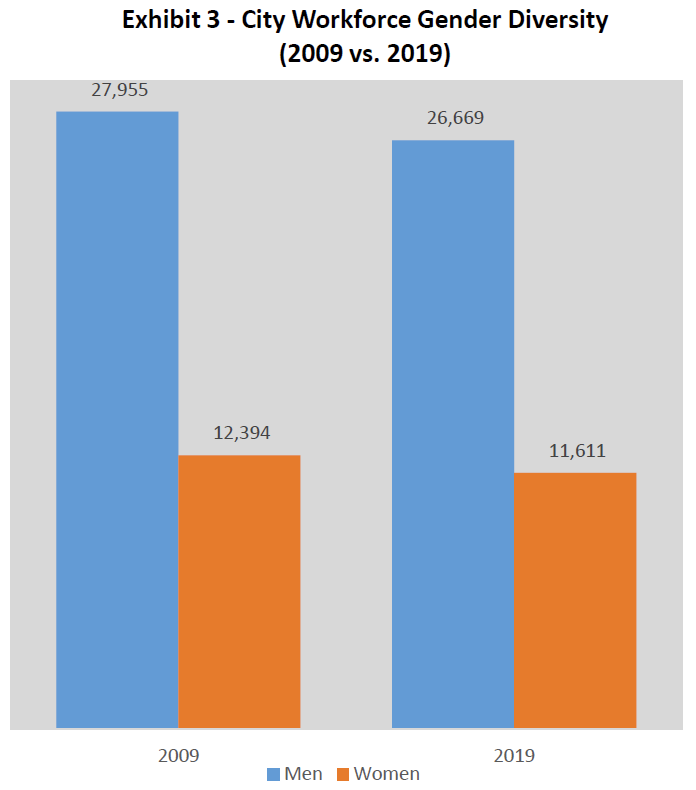
The current workforce is comprised of 63% civilian and 37% sworn employees. Sworn employees work at four City departments: Police, Fire, Harbor and Airports.
When separately evaluating the civilian and sworn workforce, there is greater gender diversity (60% men vs. 40% women) within the civilian workforce than the sworn workforce (85% men vs. 15% women) among these four departments.
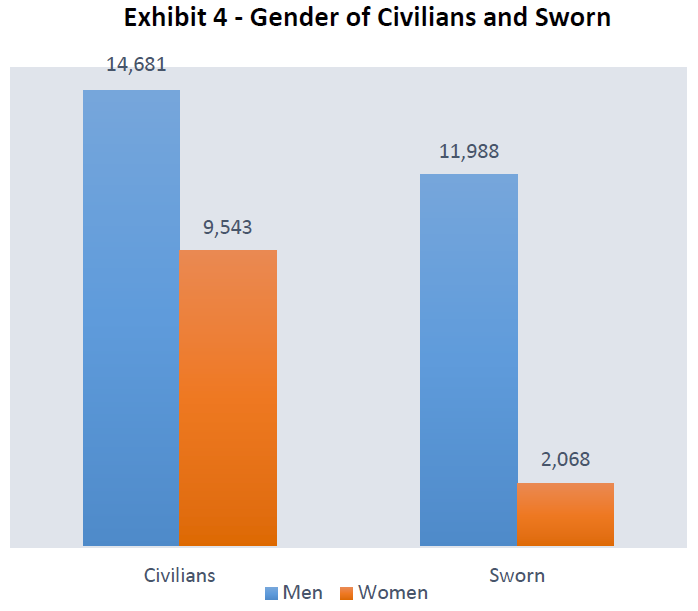
Current Workforce: Top Job Classifications
As of the end of 2019, 38% (14,644 of 38,280) of the City’s workforce was comprised of just six City job classifications. Of these, women filled the majority of the two civilian position series (Clerks and Analysts), but significantly fewer of four sworn positions (Firefighters, Police Officers, Detectives and Sergeants).
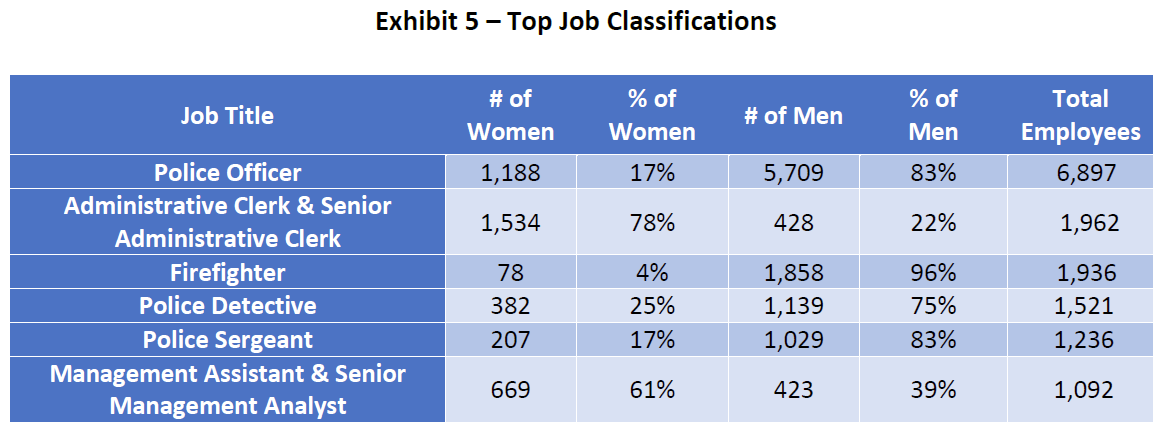
Gender Demographics of City Departments
The seven largest City departments include: Police, Water and Power, Public Works, Fire, Airports, Transportation, and General Services. Representation of women in these departments ranged from 7% to 34%; with Public Works, Fire, LADWP and General Services having less than 25% representation. Of the remaining City departments, only Building & Safety has less than 25% representation, with 197 of its 897 employees as women. A comprehensive look at all City Departments is included as an Appendix at the end of the report.

Further analysis of the largest job classifications at the following large City departments indicate that the traditionally male-dominated job classifications (e.g., equipment operators, wastewater collection, inspectors, engineers, traffic painter and sign posters, gardeners, firefighters, police officers, sergeants, detectives) continue to be represented by a majority of men and the traditionally female dominated job classifications (e.g., police service representatives (911 operators), administrative clerks, senior administrative clerks, management analysts and senior management analysts) continue to be represented by a majority of women.
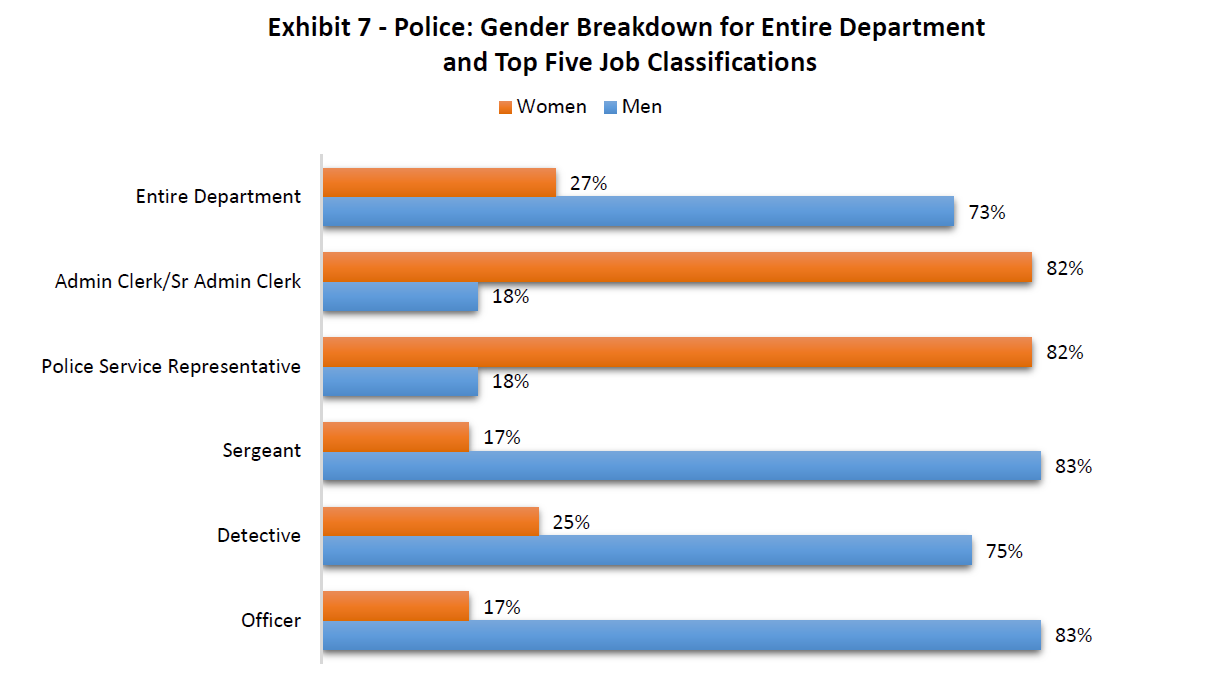

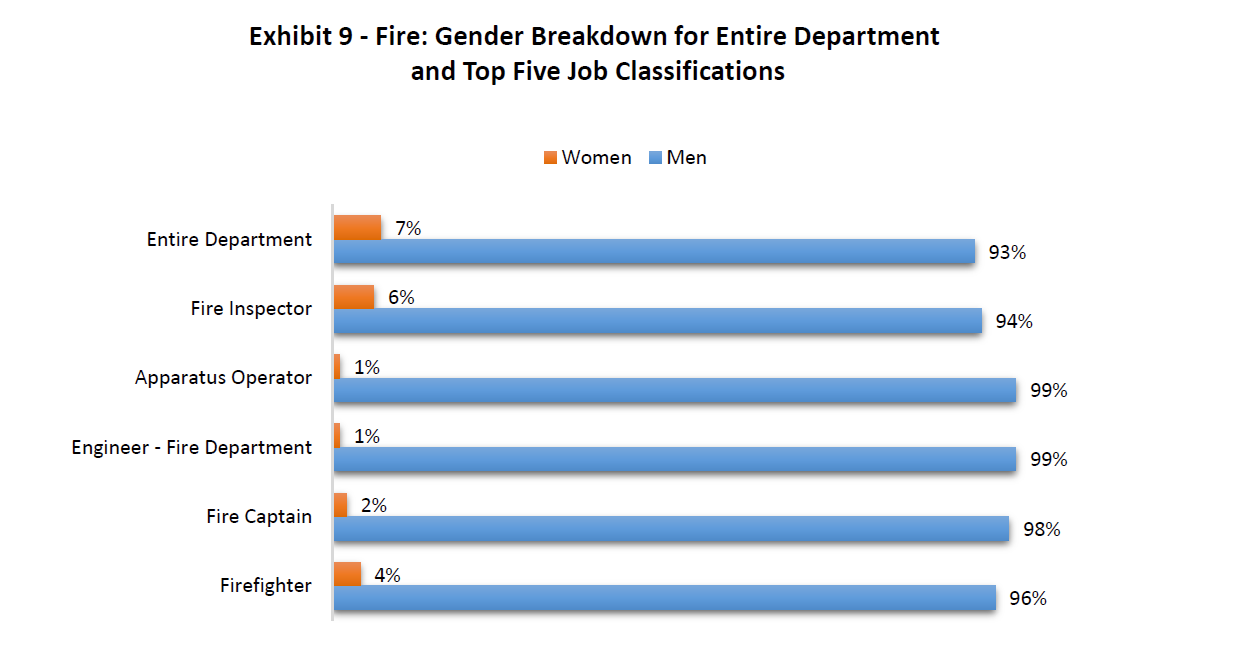

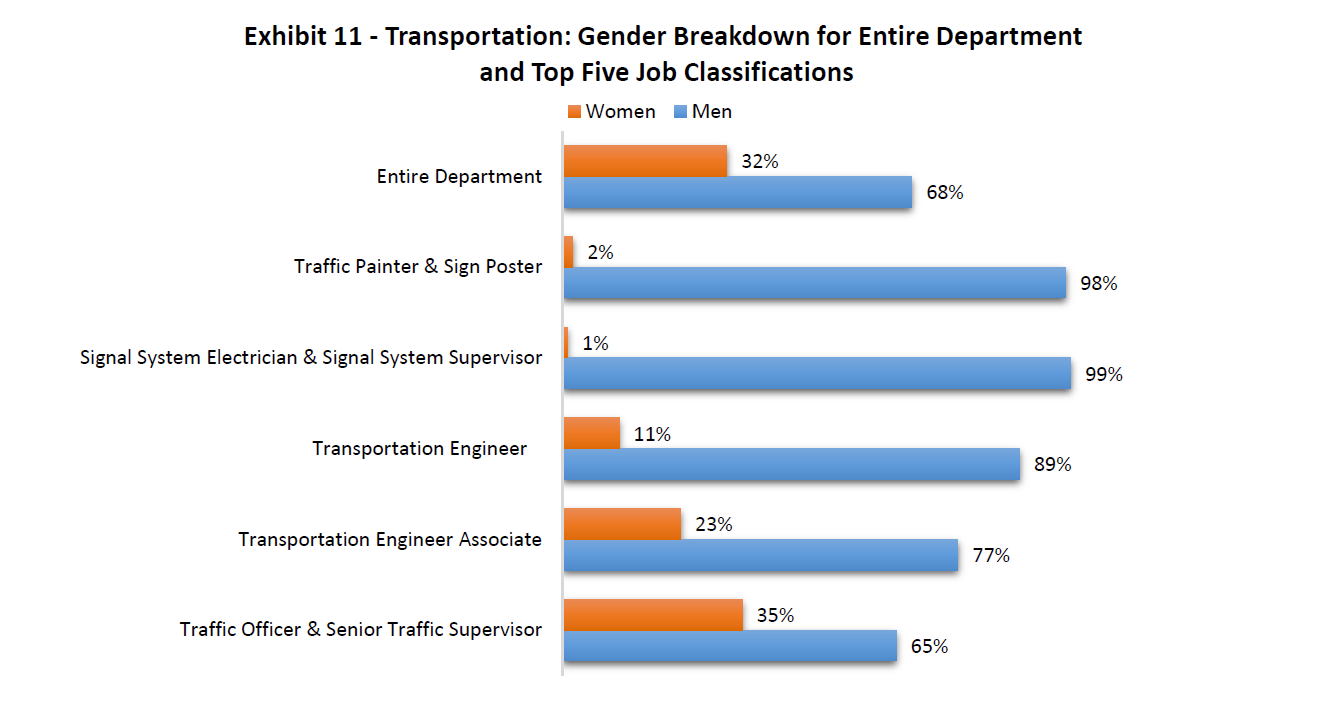
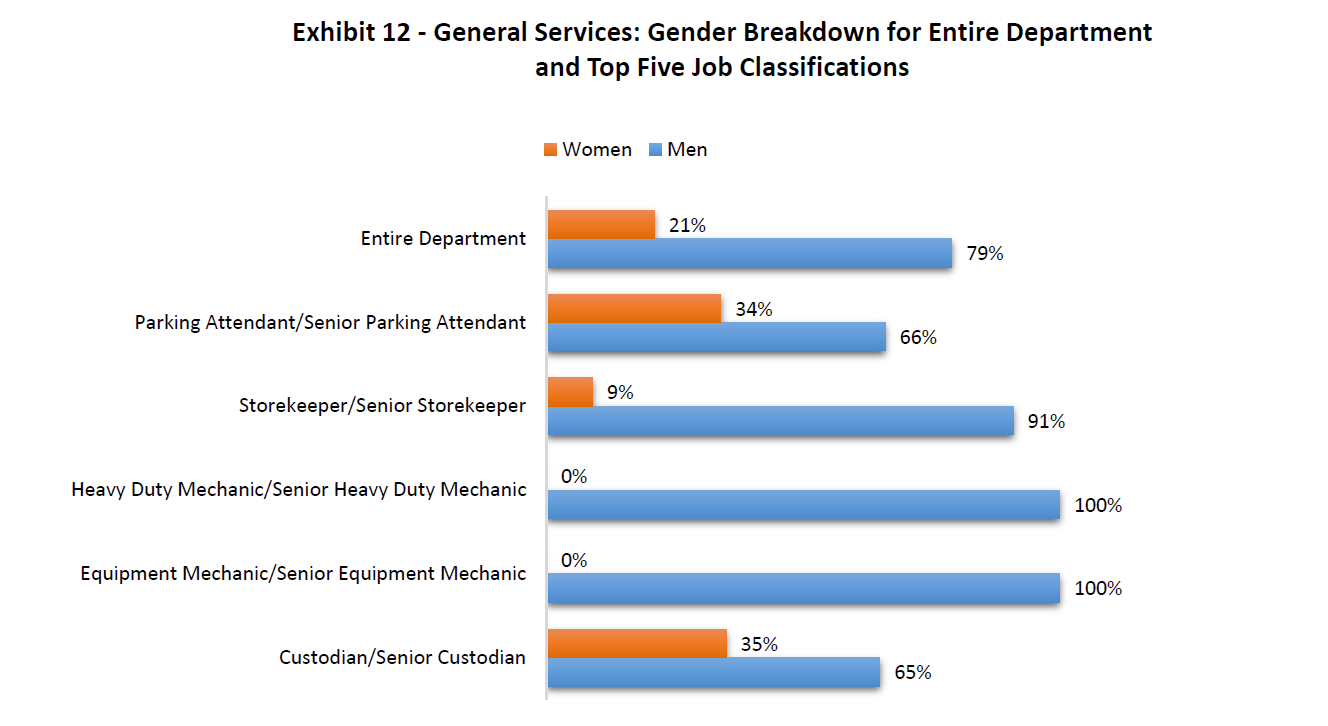
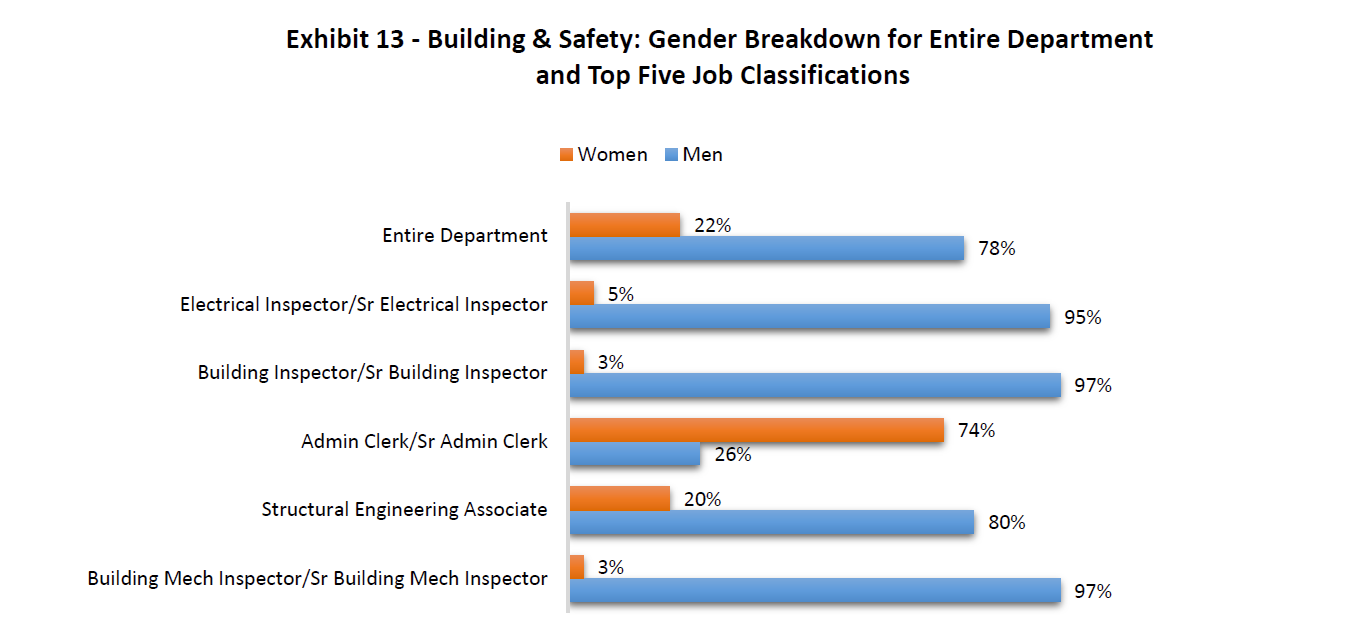
—————
[1] As of FY 2017.
[2] As of FY 2020; includes full-time and part-time employees.
Hourly Pay
Considering all City departments (except LADWP) the average full-time City worker earns $46 an hour in regular pay[3]. Men average $47 an hour, while women average $44 an hour.
Sixty-five percent of the City’s workforce are earning an hourly pay range between $30 and $59, while 16% are earning an hourly pay range of $29 or less, and 19% are earning an hourly pay range of $60 or more.

As noted in the Appendix, on average, employees at Animal Services (324), the Zoo (231), and Recreation & Parks (1,399) receive the lowest hourly pay amongst all City departments at $32, $34, and $35, respectively; while employees working in the Office of Public Accountability (4), the Office of the City Attorney (982), and the City Administrative Office (116) receive the highest hourly pay at $86, $65, and $60, respectively.
The following chart paints a picture of the hourly pay ranges of women and men in the City.
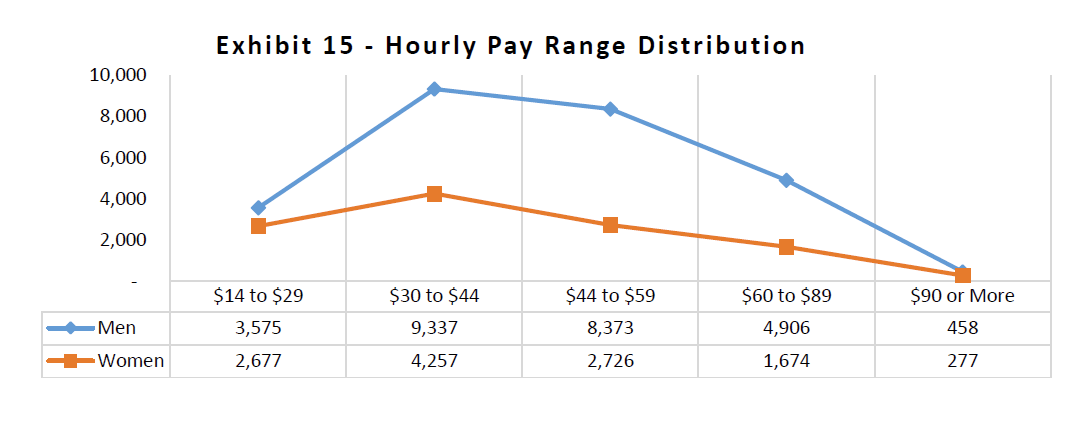
Gross Pay Analysis
Over the most recent annual period[4], 54,317 full-time City employees received almost $6 billion in gross pay. This includes regular hourly pay, bonuses, overtime, any adjustments that occurred during the year, and any payments for accrued leave at termination. Of these City employees, 15,643 (29%) were women, who were paid a total of $1,408,774,609 (averaging $90,058); while 38,674 (71%) were men who were paid $4,581,097,937 (averaging $118,454).

Focusing on the top 100 highest paid City employees for 2019, only two were women. Those women were the Chief Legislative Analyst (23rd highest paid) and the General Manager of the Los Angeles World Airports (28th highest paid). The highest paid City employee was a Chief Port Pilot.
Paid Overtime
City employees were paid $884 million in overtime earnings during the most recent annual period. The sworn employees of LAPD and LAFD earned 54% of that amount. It is interesting to note that only 9% of the total overtime paid was earned by women, including both sworn and civilians. Overtime earnings were most disproportionate for women at LAFD – Sworn; the Department with the lowest ratio of women employees, and with significant amount of overtime pay.
—————-
[3] Does not include overtime or supplemental pay, including some bonuses.
[4] For LADWP employees, this is calendar year 2019; while for the remaining City departments, this is FY 2019-20.
Recommendation #1
Develop a strategic plan with goals and strategies to attract, develop, and retain diverse talent pools and heighten the cultural competencies of City leadership and its workforce.
Recommendation #2
Require annual reports to be submitted by the Personnel Department, in conjunction with Police, Fire, Public Works, LADWP, Airports, Transportation, General Services, and Building & Safety, that formally document the City’s efforts to attract greater representation of women to entry level job classifications that have traditionally been male dominated.
Recommendation #3
Create a Working Group tasked with creating a pathway for women to better participate in all job classifications, promotions, the opportunity to earn overtime, and the ability to occupy the highest paying jobs. The Working Group would include members from the Community, Labor, CAO, and Personnel.
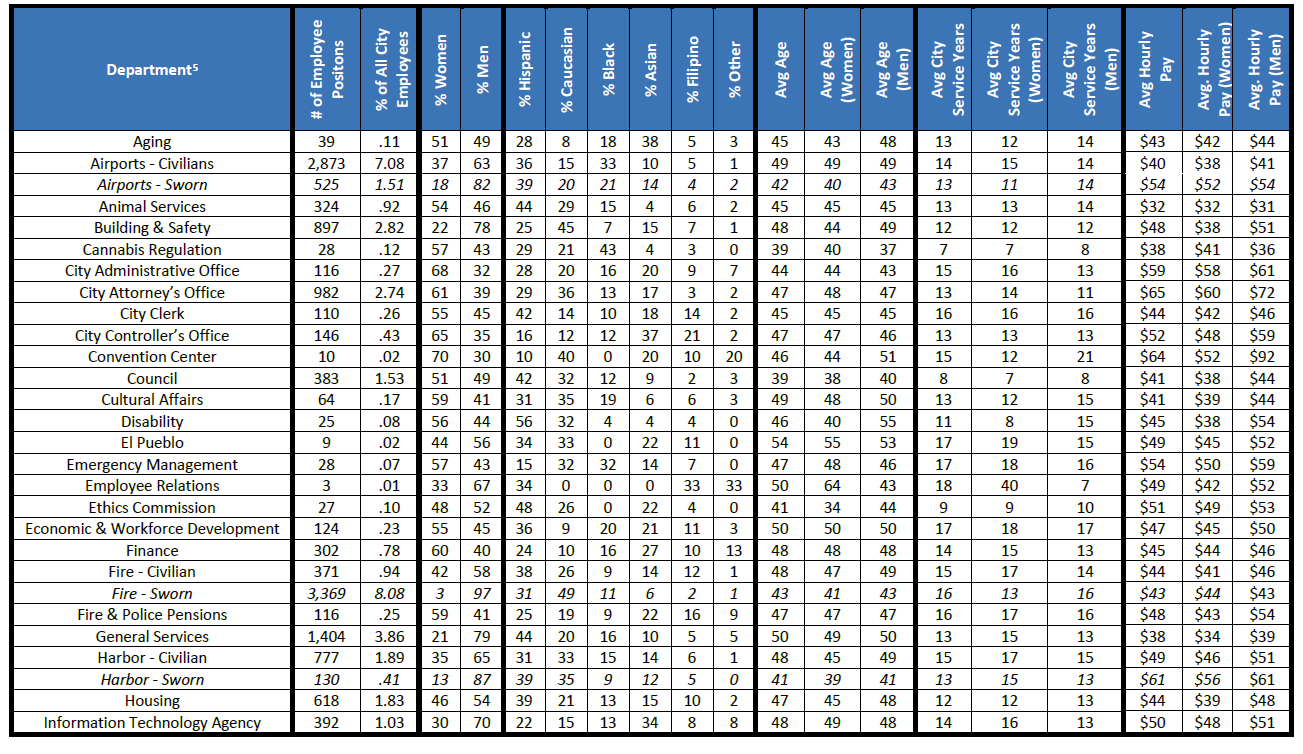
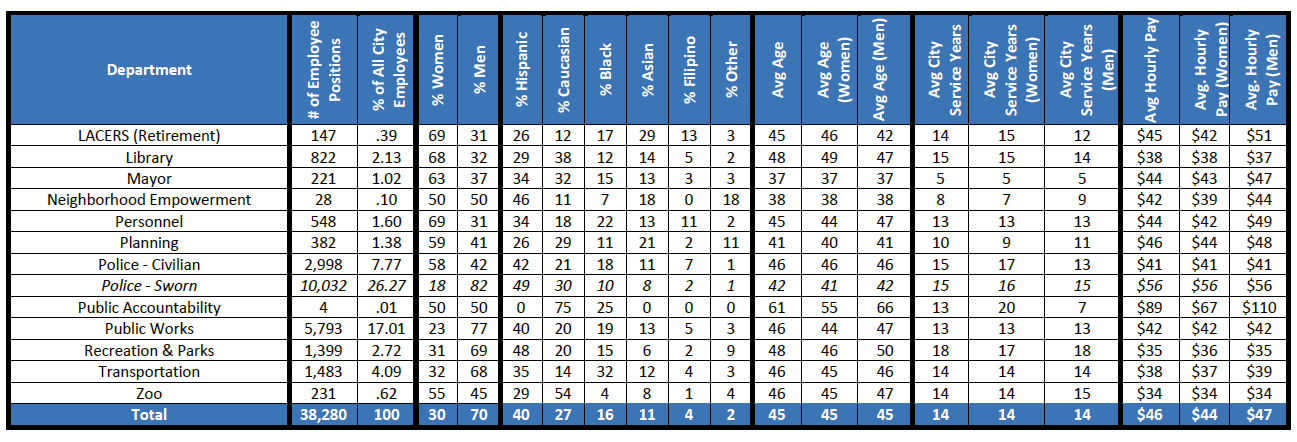
Information in this section is updated as of November 2019. Ethnicity percentages are rounded to total 100 percent.
